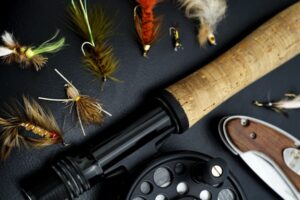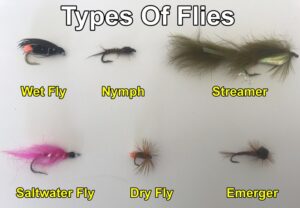What Are The Different Types Of Flies For Fly Fishing?

In fly fishing, the flies are generally divided into imitation flies and attractor flies. The flies can also be broken up further into groups or categories. In this article we will cover, “What are the different types of flies for fly fishing?”
What are imitation flies?
Imitation flies copy or imitate an insect like a terrestrial bug, aquatic insect or specific baitfish, etc. As it resembles closely to a type of food. This fly can be used to “match the hatch,” when the fish are actively feeding on one food source.
If the fly fisherman knows the fish are feeding on a certain food, like a mayfly, then the angler would fish an imitation mayfly pattern.
Or another example is beetles getting blown onto the water and the trout feeding on them. The fly pattern might be the same size, color and profile as the actual beetle.
What are attractor flies?
Attractor flies on the other hand are more of a generic fly and attracts attention.
These flies might be a bigger or flashier fly. They could suggest a type of movement or feature, but not exactly copying the food. As an example, the fly could suggest a leech, baitfish or crawfish bait all in one, but not an exact match.
An attractor pattern might be used as a searching pattern. That is when there are no active insects or food that you can see are about, so you use a fly that can stand out and hopefully attract attention and a bite.
Different types of flies.

The flies can be further be divided up, however some of flies can cross into each other. Such as wet flies and streamers. Some anglers might classify one as another depending on their country and fly fishing terminology. Emergers can also be included. The basic different types of flies are:
- Dry flies
- Wet flies
- Nymphs
- Streamers
- Saltwater flies
- Emergers.
What are dry flies?
Dry flies sit on the top of the water. They imitate insects sitting on the surface like mayflies, midges, caddis flies, beetles, grasshoppers, ants, spiders and spinners to name a few types.
Dry flies can also be called dries for short. They can be fished still, drifting with the current or wind, or fished with small twitches or rapid pulls.
Using dry flies can be an exciting experience, as you can see the fish strike the fly. Fishing with Polarized sunglasses in clear waters, where you can see the fish cruise about is exhilarating.
Dries are used seasonally in lakes and rivers and are generally effective when fish are actively feeding on insects on top of the water.
Dry flies are normally made of light buoyant materials or are tied with hackles that help the fly sit on the water surface. A floatant spray or gel is applied to the dry fly to make it buoyant. A couple of false casts will also help dry it.
Some examples of dry flies are: Royal Wulff, Adams, Griffiths Gnat, Red Tag, March Brown, Blue Dun, Black Gnat, Royal Coachman, Black Bi-Visible and Elk Caddis to name a few.
What are wet flies?
Wet flies as the name suggests are flies fished in the water, either close to the bottom, mid water or underneath the water’s surface.
The flies can imitate small baitfish, leeches, frogs, tadpoles, crawdads, and swimming aquatic insects and beetles. Or insects that have fallen into the water and are sinking.
Wets can be fished just under the surface with dead drifts, slow twitches up to fast retrieves. Some times a take will occur as the fly is sinking.
For getting wet flies deep down, weighted or bead heads are effective, especially when combined with intermediate or sinking fly lines.
Types of wet flies are: Grizzly King, Woolly Bugger, Muddler Minnow, Professor, Alexandra, Mallard and Claret, Butcher, Walker’s Killer, Mrs. Simpson and the Rabbit Fly.
What are nymphs?
Nymphs are a common worldwide food source in rivers and lakes. A good portion of a trout’s diet consists of nymphs in most seasons and waters.
Nymphs can be fished on the drop, drifting, and slow to medium retrieves, either just under the surface or deep down. They imitate the underwater stage of the insect’s life, like mayfly nymphs, stoneflies and damselfly nymphs.
A long leader and tippet is effective for nymphing, especially in clear or over fished waters. Fly fishing nymphs can be unweighted, weighted, or have bead heads.
Some examples of fly fishing nymph patterns are: Czech Nymph, Prince Nymph, Hares Ear Nymph, Pheasant Tail Nymph, Teeny Nymph and Baetis Nymph.
What are fly fishing streamers?
Artificial streamers can be colorful and have a mixture of assorted fly tying materials. Some streamers are also called bucktails, hairwing flies and tube flies. Depending on the angler or region, they might also be classified as a wet fly, or salmon fly.
Fishing streamers are bigger wet flies that can imitate baitfish like minnows, sculpins, fry and bigger appetizing food.
Streamers usually work best near the bottom or midwater and are generally quickly retrieved for salmon, bigger trout and also for saltwater fish.
Bigger flies like streamers, may also result in a bigger catch, although don’t be surprised when your four inch streamer lands a smaller twelve inch trout.
Types of fly fishing streamers are: Black Ghost, Olive Matuka, Thunder and Lightning, Alaskabou, Blue Doctor, Jock Scott, Silver Grey, Booby Fly, Black and White Bucktail, Black Demon and Mickey Finn.
What are saltwater flies?
Saltwater flies come in a wide range of assorted flies. From flies that imitate crab species, shrimp to bigger baitfish patterns, saltwater flies are the new frontier for fly tying, as the sport is relatively young.
The flies are designed to target a big variety of fish species like: bonefish, permit, striped bass, tarpon, salmon, trevally, tuna and even shark and sailfish.
Saltwater flies can be fished slowly on the bottom, or quickly retrieved midwater or on the surface, depending on the type and intended use.
Some saltwater flies are: Crazy Charlie, White Deceiver, Clouser Minnow, Dahlberg Diver, Surf Candy, Bonefish Gotcha and Lefty’s Deceiver.
Other categories of flies.
Some anglers also include emergers and fishing poppers into the different types of flies. There would be seven types then, depending on how you categorize the flies. As mentioned this would depend on the anglers view, countries terminology, etc. 1. Dry flies, 2. Wet flies, 3. Nymphs, 4. Streamers, 5. Saltwater flies, 6. Emergers, 7. Poppers.
What are emergers in fly fishing?
Emergers are insects hatching from a nymph stage to an adult stage. They struggle out of their shucks normally on the water’s surface film and emerge into an adult. The emerger might be a hatching mayfly, caddis, or midge.
For the emerger fly pattern, it can sit partially underneath the surface, or just in the waters surface film. Some emergers look like a cross between a nymph pattern and dry fly.
You can also fish an emerger pattern mid water.
Some types of emerger fly patterns are: CDC Midge Pupa, Pale Morning Dun, CDC Adams Emerger, Para Hackle Emerger and Caddis Emerger.
What are fishing poppers?
Popper flies are designed to make a lot of movement on the water’s surface with its cupped nose. Fishing poppers are a popular fly for bass.
Popper flies can also be used for saltwater as well.
Fly fishing fly tips.
(Try saying that ten times quickly.)
Dry flies, wets, nymphs and streamers are all effective in the right environment.
The secret to getting the most out your fishing is to use different techniques and test all the time. If the fishing is slow, don’t be afraid to try different types of flies and patterns. Try a slow retrieve or a quick long retrieve with an attractor pattern.
If the fish are not actively feeding close to the top, try fishing deeper down. Fish around structures like weed beds, rocks and submerged trees, deep pools, undercuts, dam walls, piers, drop-offs and channels.
Try inlets and outlets, where streams and rivers run into each other or enter a lake or pond. These place are worth fishing, especially if the weather is hot as oxygen levels in the water might be low.
Try fishing at dusk or dawn, or during the night when a lot of fish species are active. Click on Night Fishing for more information.
For learning how to cast for beginners, visit How To Fly Fish.
FAQ. (Frequently Asked Questions.)
Are nymphs, wet or dry flies?
Nymphs are generally fished under water so they called be called a wet fly. But generally they are classified as a nymph in its separate classification.
What are terrestrial insects?
Terrestrial insects live on the land. For fly fishing, a terrestrial insect could be beetle, ants, grasshoppers and crickets that have blown onto the water.
What are aquatic insects?
Aquatic insects live in the water, or live a portion of their life in the water. They could be a water beetle, or a semi-aquatic insect like a dragonfly nymph, stonefly nymph, caddis larvae and damselfly nymph.
Conclusion – What are the different types of flies for fly fishing?
Flies can be divided into imitation patterns and attractor patterns.
The flies can also be categorized into dry flies, wet flies, nymphs, streamers and saltwater flies. There are no real strict guidelines for classifying the flies and depending on the country, tradition and terminology, some anglers may also classify emerges and popper flies as another category of flies.
Regardless of how you classify your flies, just make sure you have different types of flies to cover different fly fishing conditions and techniques.
Good luck and good fishing.









